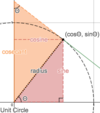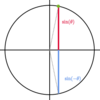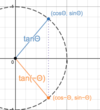Trig Identities Flashcards
What are
identities
used for?
Rewriting
- *expressions** in
- *equivalent**, but
- *more useful**, forms.
Reciprocal and quotient identities:
sec (Θ) = ___
Reciprocal and quotient identities:
sec (Θ) = 1
cos (Θ)
Cosine and secant always multiply exactly to 1.
(They are reciprocal functions.)
In the right triangle definitions, cosine is adjacent over hypotenuse, and secant is hypotenuse over adjacent. In the unit circle, the adjacent side is the radius with length 1, so it simplifies to just the hypotenuse.

Reciprocal and quotient identities:
csc (Θ) = ___
Reciprocal and quotient identities:
csc (Θ) = 1
sin (Θ)
Sine and cosecant always multiply exactly to 1.
(They are reciprocal functions.)
In the right triangle definitions, sine is opposite over hypotenuse, and cosecant is hypotenuse over opposite. In the unit circle, the opposite side is the radius with length 1, so it simplifies to just the hypotenuse.

Reciprocal and quotient identities:
tan (Θ) = ___
Reciprocal and quotient identities:
tan (Θ) = sin (Θ)
cos (Θ)
Right triangle definition:
opposite
adjacent
Unit circle definition:
sin (Θ)
cos (Θ)
Same Θ in multiple right triangles, so
tan (Θ) must be the same.

Reciprocal and quotient identities:
- *cot (Θ) = ___**
- (two things)*
Reciprocal and quotient identities:
cot (Θ) = 1 = cos (Θ)
tan (Θ) sin (Θ)
Tangent and cotangent always multiply exactly to 1.
(They are reciprocal functions.)
Cotangent is defined as adjacent over opposite. In the unit circle, the opposite side is the radius with length 1, so it simplifies to just the adjacent.

Symmetry and periodicity identities:
sin (−Θ) = ___
sin (−Θ) = −sin (Θ)

Symmetry and periodicity identities:
cos (−Θ) = ___
cos (−Θ) = cos (Θ)

Symmetry and periodicity identities:
tan (−Θ) = ___
tan (−Θ) = −tan (Θ)
Proof:
- tan (Θ) = sin (Θ)
cos (Θ)
(unit circle definition) - tan (−Θ) = sin (−Θ)
cos (−Θ)
(substitution) - tan (−Θ) = − sin (−Θ)
cos (Θ)
(symmetry identities) - tan (−Θ) = −tan (Θ)

Symmetry and periodicity identities:
sin (Θ + ___) = sin (Θ)
2π
Symmetry and periodicity identities:
cos (Θ + ___) = cos (Θ)
2π
Symmetry and periodicity identities:
tan (Θ + ___) = tan (Θ)
π
Cofunction identities:
cos (90° − Θ) = ___
sin (Θ)
All the cofunction identities look the same.
Going from Θ to 90°−Θ is
equivalent to
reflecting the angle over the line
y = x.

Cofunction identities:
In radians,
how would you write
cos (Θ) in terms of its
cofunction?
cos (Θ) =
sin (π/2 − Θ)
All the cofunction identities look the same.
Going from Θ to π/2 − Θ is
equivalent to
reflecting the angle over the line
y = x.
Cofunction identities:
sec (90° − Θ) = ___
csc(Θ)
All the cofunction identities look the same.
Going from Θ to 90°−Θ is
equivalent to
reflecting the angle over the line
y = x.
Cofunction identities:
In radians,
how would you write
sec (Θ) in terms of its
cofunction?
sec (Θ) =
csc (π/2 − Θ)
All the cofunction identities look the same.
Going from Θ to π/2 − Θ is
equivalent to
reflecting the angle over the line
y = x.
Cofunction identities:
tan (90° − Θ) = ___
cot (Θ)
All the cofunction identities look the same.
Going from Θ to 90°−Θ is
equivalent to
reflecting the angle over the line
y = x.
Cofunction identities:
In radians,
how would you write
tan (Θ) in terms of its
cofunction?
tan (Θ) =
cot (π/2 − Θ)
All the cofunction identities look the same.
Going from Θ to π/2 − Θ is
equivalent to
reflecting the angle over the line
y = x.
Pythagorean identities:
What is the
Pythagorean identity?
sin2 (Θ) + cos2 (Θ) = 12,
which simplifies to

sin2 (Θ) + cos2 (Θ) = 1
It comes from applying the Pythagorean theorem to the right triangle below.
Pythagorean identities:
Arrange the following into a Pythagorean identity:
tan2 (Θ), sec2 (Θ), 1.
tan2 (Θ) + 1 = sec2 (Θ)
It comes from applying the Pythagorean theorem to the right triangle below.

Pythagorean identities:
Arrange the following into a Pythagorean identity:
1, csc2 (Θ), cot2 (Θ).
cot2 (Θ) + 1 = csc2 (Θ)
It comes from applying the Pythagorean theorem to the right triangle below.

Angle sum and difference identities:
sin (A + B) = ___
sin (A + B) =
sin (A) cos (B) + cos (A) sin (B)

Directly from the diagram below.
Angle sum and difference identities:
sin (A − B) = ___
sin (A − B) =
sin (A) cos (B) − cos (A) sin (B)
Can be proved from the sum formula.
Proof:
- sin (A + B) = sin (A) cos (B) + cos (A) sin (B)
(sum formula) - cos (−B) = cos (B)
(symmetry identity) - sin (−B) = −sin (B)
(odd function identity) - sin (A + (−B)) = sin (A) cos (−B) + cos (A) sin (−B)
(substitution) -
sin (A − B) = sin (A) cos (B) − cos (A) sin (B)
[sign change] [no sign change] [sign change]
Angle sum and difference identities:
cos (A + B) = ___
cos (A + B) =
cos (A) cos (B) − sin (A) sin (B)
Directly from the diagram below.

Angle sum and difference identities:
cos (A − B) = ___
cos (A − B) =
cos (A) cos (B) + sin (A) sin (B)
Can be proved from the sum formula.
Proof:
- cos (A + B) = cos (A) cos (B) − sin (A) sin (B)
(sum formula) - cos (−B) = cos (B)
(symmetry identity) - sin (−B) = −sin (B)
(odd function identity) - cos (A + (−B)) = cos (A) cos (−B) − sin (A) sin (−B)
(substitution) -
cos (A − B) = cos (A) cos (B) + sin (A) sin (B)
[sign change] [no sign change] [sign change]
Angle sum and difference identities:
tan (A + B) = ___
tan (A + B) =
tan (A) + tan (B)
1 − tan (A) • tan (B)
Proof:
- tan (A) = sin (A)
cos (A)
(definition of tangent) - tan (A + B) = sin (A + B)
cos (A + B)
(substitution) - = sin (A) cos (B) + cos (A) sin (B)
cos (A) cos (B) − sin (A) sin (B)
(sine and cosine addition formulae) - = sin (A) cos (B) + cos (A) sin (B) (÷ cos (A) cos (B))
cos (A) cos (B) − sin (A) sin (B) (÷ cos (A) cos (B))
(dividing numerator and denominator by same value) -
( sin (A) / cos (A)) + sin (B) / cos (B))
1 − (sin (A) sin (B)) / (cos (A) cos (B))
(expanding division to each term) -
= tan (A) + tan (B)
1 − tan (A) • tan (B)
(simplifying with definition of tangent)
Angle sum and difference identities:
tan (A − B) = ___
tan (A − B) =
tan (A) − tan (B)
1 + tan (A) • tan (B)
Same as the tangent angle addition formula with the signs reversed.
Proof:
- tan (A + B) = tan (A) + tan (B)
1 − tan (A) • tan (B)
(tangent angle addition formula) - tan (−B) = −tan (B)
(tangent symmetry identity) - tan (A + (−B)) = tan (A) + tan (−B)
1 − tan (A) • tan (−B)
(substitution) - = tan (A) − tan (B)
1 + tan (A) • tan (B)
Double angle identities:
sin (2A) = ___
sin (2A) =
2 sin (A) cos (A)
Proof:
- sin (A + B) = sin (A) cos (B) + cos (A) sin (B)
- (sine angle addition formula)*
- 2A = A + A
- sin (A + A) = sin (A) cos (A) + cos (A) sin (A)
- (substitution)*
- = 2 sin (A) cos (A)
Double angle identities:
cos (2A) = ___
cos (2A) =
2 cos2 (A) − 1
Proof:
- cos (A + B) = cos (A) cos (B) − sin (A) sin (B)
(cosine angle addition formula) - 2A = A + A
- cos (A + A) = cos (A) cos (A) − sin (A) sin (A)
(substitution) - cos (2A) = cos2 (A) − sin2 (A)
- sin2 (A) + cos2 (A) = 1
sin2 (A) = 1 − cos2 (A)
(Pythagorean identity) - cos (2A) = cos2 (A) − (1 − cos2 (A))
(substitution) - = cos2 (A) − 1 + cos2 (A)
(distribute negative sign) - = 2cos2 (A) − 1
Double angle identities:
tan (2A) = ___
tan (2A) =
2 tan (A)
1 − tan2 (A)
Proof:
- tan (A + B) = tan (A) + tan (B)
1 − tan (A) • tan (B)
(tangent angle addition formula) - 2A = A + A
- tan (A + A) = tan (A) + tan (A)
1 − tan (A) • tan (A)
(substitution) - = 2 tan (A)
1 − tan2 (A)


